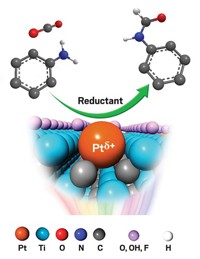Advertisement
Grab your lab coat. Let's get started
Welcome!
Welcome!
Create an account below to get 6 C&EN articles per month, receive newsletters and more - all free.
It seems this is your first time logging in online. Please enter the following information to continue.
As an ACS member you automatically get access to this site. All we need is few more details to create your reading experience.
Not you? Sign in with a different account.
Not you? Sign in with a different account.
ERROR 1
ERROR 1
ERROR 2
ERROR 2
ERROR 2
ERROR 2
ERROR 2
Password and Confirm password must match.
If you have an ACS member number, please enter it here so we can link this account to your membership. (optional)
ERROR 2
ACS values your privacy. By submitting your information, you are gaining access to C&EN and subscribing to our weekly newsletter. We use the information you provide to make your reading experience better, and we will never sell your data to third party members.
Synthesis
Borophene units split water
Graphenelike groupings of boron atoms in molybdenum diboride actively catalyze hydrogen evolution reaction
by Mitch Jacoby
July 24, 2017
| A version of this story appeared in
Volume 95, Issue 30

A molybdenum-boron material functions as a highly active catalyst for the hydrogen evolution reaction, one of the key steps in liberating hydrogen from water (J. Am. Chem. Soc. 2017, DOI: 10.1021/jacs.7b06337). The promise of a practically limitless supply of clean-burning hydrogen fuel from water spurs scientists to find catalysts that split water into hydrogen and oxygen. Platinum works well, but it’s expensive. MoS2 is a low-cost substitute, but it tends to work best at current densities such as 10 mA/cm2 that are too low for large-scale industrial applications. Tewodros Asefa of Rutgers University, Xiaoxin Zou of Jilin University, and coworkers have come up with a precious-metal-free, high-performing alternative: the α phase of MoB2. The material consists of two-dimensional graphenelike boron structures—borophene units—inserted into a metallic 3-D molybdenum framework. The team reports that α-MoB2 outperforms MoS2 and even outperforms Pt-C reference catalysts, readily delivering current densities on the order of 1,000 mA/cm2. The team attributes α-MoB2’s catalytic prowess to its high electronic conductivity, high density of catalytic sites, and good mass-transport properties.





Join the conversation
Contact the reporter
Submit a Letter to the Editor for publication
Engage with us on Twitter